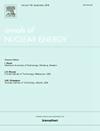Results of the SSM-SICOPS melt tests of the EU-SAFEST project
IF 1.9
3区 工程技术
Q1 NUCLEAR SCIENCE & TECHNOLOGY
引用次数: 0
Abstract
Within the EU-SAFEST project, the Swedish Radiation Safety Authority (SSM) proposed to perform tests on molten corium-concrete interaction (MCCI) with basaltic concrete and BWR-specific corium, characterized by a higher Zr/U ratio than PWR corium.
These tests (denoted SSM-1a/2b/2c/3) were carried out in Framatome’s SICOPS facility in Erlangen. Once the melt initially containing ≈75 wt% UO2, ≈17 wt% ZrO2, was generated and its interaction with the concrete had started, metallic Zr was subsequently added to the melt from the top.
All tests showed a fast concrete ablation by the melt, faster than in previous SICOPS experiments without Zr addition, most likely due to the higher temperature of the melt caused by the Zr oxidation. The absence of crusts and even erosion profiles at the bottom seen during post-test examination support the assumption of a homogeneously mixed melt pool during MCCI.
In the presence of high melt temperatures and the vivid mixing by rising concrete decomposition gases, local crusts between melt and concrete should not be stable and no evidence for them has been found. As the formation of such crusts is seen as the main potential mechanism for anisotropic concrete ablation in the early stages of an MCCI, the investigated conditions with Zr being present in the melt can be considered capable of suppressing this effect. This is important since the core melt, after its release from the RPV, typically contains a high fraction of non-oxidized Zr.
While no crusts were found at the interface, sampling in the late phase of the SSM-3 test revealed evidence for the formation of a kind of transition zone between melt and concrete. This conclusion was drawn based on tactile feedback during sampling from the bottom of the melt pool where a soft/viscous zone could be felt and from the appearance of taken samples including small solid aggregates from the transition zone.
Gas measurements during SSM-3 showed a significant H2 production, due to the reaction of water from the concrete with metallic zirconium. The peaks in the H2 concentration occurred when the concrete erosion velocities were highest. This confirms that, even at high erosion and superficial gas rates, the Zr in the bulk is still capable of reducing the percolating steam.
欧盟最安全项目的SSM-SICOPS熔体测试结果
在欧盟最安全的项目中,瑞典辐射安全局(SSM)提议对玄武岩混凝土和沸水堆专用堆芯的熔融堆芯-混凝土相互作用(MCCI)进行测试,其特点是Zr/U比高于压水堆堆芯。这些试验(编号SSM-1a/2b/2c/3)在Erlangen的Framatome SICOPS设施中进行。一旦熔体最初含有≈75 wt%的UO2,≈17 wt%的ZrO2,并且它与混凝土的相互作用开始,金属Zr随后从顶部添加到熔体中。所有的测试都显示熔体对混凝土的快速烧蚀,比以前没有添加Zr的SICOPS实验快,很可能是由于Zr氧化引起的熔体温度更高。在试验后检查中看到的底部没有结壳和甚至侵蚀剖面支持了MCCI期间均匀混合熔池的假设。在熔体温度高和混凝土分解气体上升的剧烈混合的情况下,熔体和混凝土之间的局部结壳不应该是稳定的,而且没有证据表明存在这种结壳。由于这种结壳的形成被认为是MCCI早期混凝土各向异性烧蚀的主要潜在机制,因此所研究的熔体中存在Zr的条件可以被认为能够抑制这种影响。这一点很重要,因为堆芯熔体从RPV中释放出来后,通常含有很高比例的未氧化锆。虽然在界面处没有发现结壳,但SSM-3试验后期的取样显示,在熔体和混凝土之间形成了一种过渡区。这一结论是基于从熔池底部取样时的触觉反馈得出的,在那里可以感觉到软/粘性区,以及从过渡区采集的样品的外观,包括小的固体聚集体。SSM-3期间的气体测量显示,由于混凝土中的水与金属锆发生反应,产生了显著的氢气。H2浓度的峰值出现在混凝土侵蚀速度最大的时候。这证实了,即使在高侵蚀和表面气体速率下,大块中的Zr仍然能够减少渗透蒸汽。
本文章由计算机程序翻译,如有差异,请以英文原文为准。
求助全文
约1分钟内获得全文
求助全文
来源期刊

Annals of Nuclear Energy
工程技术-核科学技术
CiteScore
4.30
自引率
21.10%
发文量
632
审稿时长
7.3 months
期刊介绍:
Annals of Nuclear Energy provides an international medium for the communication of original research, ideas and developments in all areas of the field of nuclear energy science and technology. Its scope embraces nuclear fuel reserves, fuel cycles and cost, materials, processing, system and component technology (fission only), design and optimization, direct conversion of nuclear energy sources, environmental control, reactor physics, heat transfer and fluid dynamics, structural analysis, fuel management, future developments, nuclear fuel and safety, nuclear aerosol, neutron physics, computer technology (both software and hardware), risk assessment, radioactive waste disposal and reactor thermal hydraulics. Papers submitted to Annals need to demonstrate a clear link to nuclear power generation/nuclear engineering. Papers which deal with pure nuclear physics, pure health physics, imaging, or attenuation and shielding properties of concretes and various geological materials are not within the scope of the journal. Also, papers that deal with policy or economics are not within the scope of the journal.
 求助内容:
求助内容: 应助结果提醒方式:
应助结果提醒方式:


